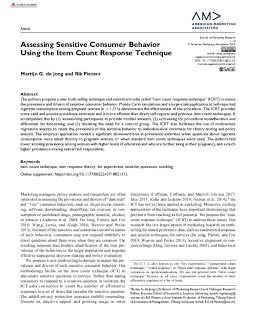2018
Assessing Sensitive Consumer Behavior Using the Item Count Response Technique
Publication
Publication
The authors propose a new truth-telling technique and statistical model called “item count response technique” (ICRT) to assess the prevalence and drivers of sensitive consumer behavior. Monte Carlo simulations and a large-scale application to self-reported cigarette consumption among pregnant women (n ¼ 1,315) demonstrate the effectiveness of the procedure. The ICRT provides more valid and precise prevalence estimates and is more efficient than direct self-reports and previous item count techniques. It accomplishes this by (1) incentivizing participants to provide truthful answers, (2) accounting for procedural nonadherence and differential list functioning, and (3) obviating the need for a control group. The ICRT also facilitates the use of multivariate regression analysis to relate the prevalence of the sensitive behavior to individual-level covariates for theory testing and policy analysis. The empirical application reveals a significant downward bias in prevalence estimates when questions about cigarette consumption were asked directly to pregnant women, or when standard item count techniques were used. The authors find lower smoking prevalence among women with higher levels of education and who are further along in their pregnancy, and a much higher prevalence among unmarried respondents.
| Additional Metadata | |
|---|---|
| , , , , | |
| doi.org/10.1177/0022243718821312, hdl.handle.net/1765/112596 | |
| Journal of Marketing Research | |
| Organisation | Department of Business Economics |
|
de Jong, M., & Pieters, R. (2018). Assessing Sensitive Consumer Behavior Using the Item Count Response Technique. Journal of Marketing Research. doi:10.1177/0022243718821312 |
|

